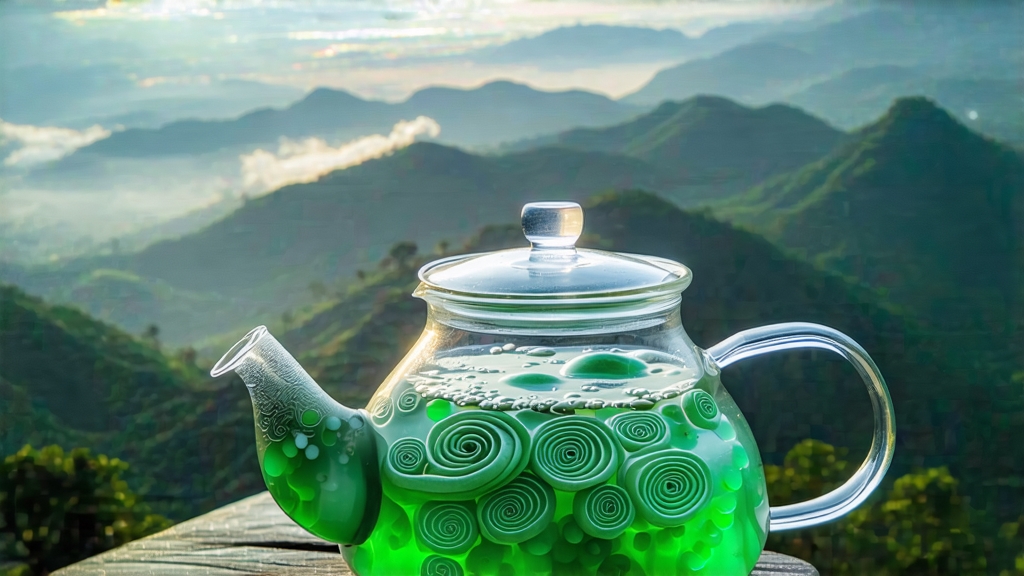
Biluochun, whose name translates literally to “Green Snail Spring,” is one of China’s ten most celebrated teas, yet it remains a quiet revelation for many international drinkers. Grown in the lake-cradled hills of Dongting Mountain near Suzhou, Jiangsu Province, this emerald-green tea is prized for its tiny spiral-shaped leaves, an aroma that carries the unexpected perfume of apricots and white flowers, and a cup that tastes like the first warm breeze after winter. To understand Biluochun is to step into a 1,200-year-old story that weaves imperial whim, Buddhist monks, micro-climates, and meticulous hand-craft into every gram.
Historical whispers place the tea’s birth during the Tang dynasty, but its fame crystallized in the Kangxi era of the Qing. Touring the region in 1699, the emperor was offered a small jar of unusually fragrant leaf. Struck by the scent, he asked its name; locals replied “Xia Sha Ren Xiang,” literally “scary fragrance,” because the perfume was so intense it startled people. The emperor, finding the name inelegant, rechristened it Biluochun for its snail-shell curl and spring harvest. From that moment the tea entered tribute status, and imperial barges carried it north along the Grand Canal to the Forbidden City.
Geography is the first secret. Dongting Mountain is actually two islands—East and West—rising from Lake Tai, China’s third-largest freshwater body. The lake moderates temperature, while morning mist filters sunlight, slowing photosynthesis and coaxing the leaves to stockpile amino acids that translate into sweetness. Thin, well-draining acidic soil, peppered with granite fragments, forces the bushes to struggle, concentrating flavor. Finally, fruit orchards—peach, plum, apricot—intercrop with tea, and their pollen drifts onto the leaf surface, accounting for the tea’s signature floral note that arrives before you even take a sip.
Although all Biluochun shares the same genetic cultivar—Fuding Small-Leaf—farmers recognize three micro-origin grades. “Original Mountain” denotes leaves picked on the islands themselves; “Nearby Mountain” comes from the immediate lake shore; “Outer Mountain” arrives from outlying counties. Purists insist only island tea possesses the elusive “lake yun,” a mineral aftertaste reminiscent of stones warmed by sun and spray. Within each zone, picking standards subdivide further: one bud, one bud-and-half-open-leaf, or one-bud-and-two-leaves. The smallest, most tender grade, called “Special Supreme,” requires roughly 70,000 buds to yield one kilogram of finished tea.
Crafting Biluochun is a race against time and oxidation. Picking begins before sunrise on Qingming festival, when overnight dew keeps cells turgid and prevents bruising. Leaves arrive at the village workshop within two hours; any delay invites unwanted fermentation. The first step, “kill-green,” uses woks heated to 180 °C. A master fryer tosses 250 g of leaf at a time, flicking his wrists so the buds arc through the air like green fireworks. Thirty seconds of contact deactivates enzymes, sets the jade color, and drives off grassy volatiles. Immediately the temperature drops to 80 °C for the rolling phase. Here the maker presses, rubs, and spirals the hot leaf against the wok’s wall, coaxing it into the signature tight curl while rupturing cell walls so sap coats the surface. When the leaf feels like cool velvet, it is briefly rested, then given a final low-temperature bake that locks in fragrance. The entire cycle—pluck to finished tea—takes less than four hours.
Judging quality begins with the dry leaf. Supreme grades show downy silver tips interlaced with deep jade coils; no stalks, no碎片. A gentle shake in a porcelain gaiwan releases a scent that should suggest fresh lychee, freesia, and a hint of seawater. Once brewed, the leaves unfurl in slow motion, revealing the intact bud like a miniature sword pointing upward, a phenomenon Chinese drinkers call “the upright spear of spring.”
Water choice is critical. Lake Tai spring water is ideal, but any neutral, low-mineral water around 75 °C works. Higher temperatures scorch the fuzz and draw bitterness; cooler fails to awaken the aromatics. Use a tall glass or glass teapot so you can watch the show: three grams of leaf, 150 ml of water, poured in a high, thin stream to agitate. The spirals